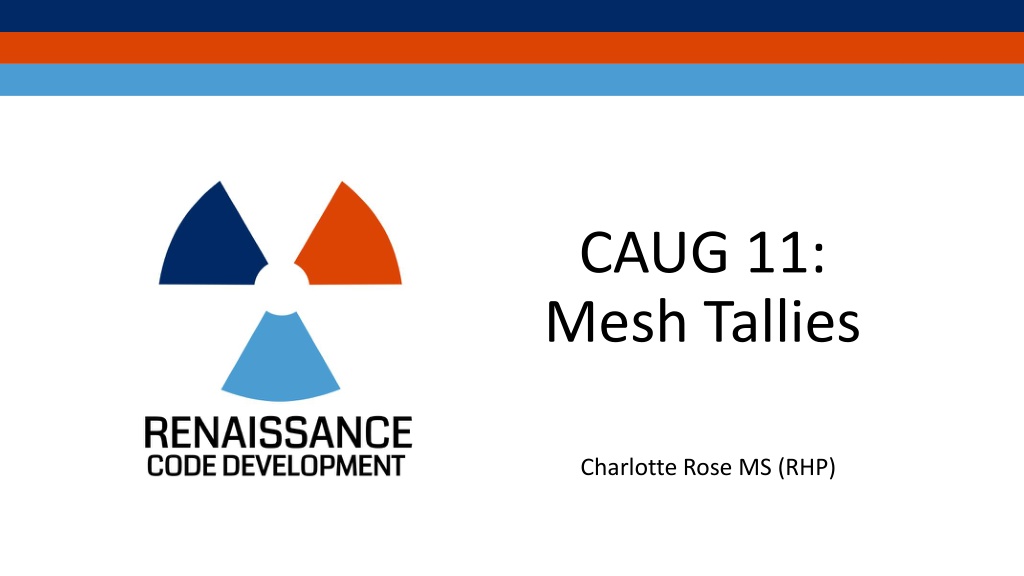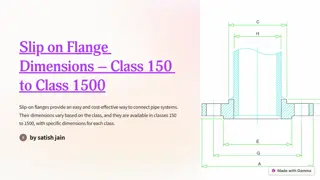
Understanding Mesh Tallies in Nuclear Engineering
Explore the world of mesh tallies in nuclear engineering, covering topics such as basic concepts, advantages, disadvantages, and practical applications. Dive into the details of MCNP input file syntax, statistical considerations, and the use of PIMAL phantoms for tallying in detailed grids.
Download Presentation

Please find below an Image/Link to download the presentation.
The content on the website is provided AS IS for your information and personal use only. It may not be sold, licensed, or shared on other websites without obtaining consent from the author. If you encounter any issues during the download, it is possible that the publisher has removed the file from their server.
You are allowed to download the files provided on this website for personal or commercial use, subject to the condition that they are used lawfully. All files are the property of their respective owners.
The content on the website is provided AS IS for your information and personal use only. It may not be sold, licensed, or shared on other websites without obtaining consent from the author.
E N D
Presentation Transcript
Corvallis, Seattle, and Austin CAUG 11: Mesh Tallies Charlotte Rose MS (RHP)
Corvallis, Seattle, and Austin Last Class Tally fundamentals Sharing 2
Corvallis, Seattle, and Austin Intermediate MCNP Mesh Tallies MCNP input file syntax Mesh tally plotting would love to show you but I learned that I am missing an important bit of software/setup, and so we will go through that as we start advanced. It might be more appropriate there, anyway. 3
Corvallis, Seattle, and Austin Tallies At the heart of our work Accounting of activities What the statistics are reported on; statistics are not a report of the problem or model as a whole Remember from first class: we cannot recover lost info! (be careful of areas with zero importance, and tally where you want to without ignoring other areas you think won t sample) 7 types; FMESH tallies only type 4 4
Corvallis, Seattle, and Austin This is one of the times Tally Comment can be really helpful since we will likely not read this from the output file, rather the meshtally file. 5
Corvallis, Seattle, and Austin Mesh tallies Advantages Do not need cell Can provide a lot of information Make a heat/dose map or graph an attenuation coefficient Disadvantages Can be hard to read Only error is reported (1/10 statistical checks) Take care to understand if there are more than one materials in the area tallied 6
Corvallis, Seattle, and Austin PIMAL phantom Use a base model with already determined geometry and put a tally in a location Put a grid of tallies in a location Grid the entire room 7
Corvallis, Seattle, and Austin FMESH syntax for cartesian meshes FMESH4:P GEOM=REC ORIGIN= starting points (x,y,z) IMESH x end points IINTS how many steps between x JMESH y end points JINTS how many steps between y KMESH z end points KINTS how many steps between z OUT IJ/IK/JK FM -1 0 -4 (turns it into an energy deposition tally mev/g) 8
Corvallis, Seattle, and Austin FMESH syntax for cylindrical meshes FMESH4:P GEOM=CYL ORIGIN= Base of cylinder (x,y,z) IMESH radius from 0 to this # IINTS how many steps between radii /vec JMESH heigh gradations JINTS how many steps for height/axs KMESH rotational end point KINTS how many radial divisions from 0 (default start 0, to 1 in whole revolutions; 1 is 360 degrees) AXS axis vector VEC radial vector OUT IJ/IK/JK (optional, but I like this for 3D outputs) DE DF for dose conversion factors (cannot use pre built modifiers) 9
Corvallis, Seattle, and Austin MESHTAL file This can be when using the i= and n= commands can be very helpful!! How to read it little description Simplifying with FC (comment) Output comparison Using Excel to help graph/convert 10






















